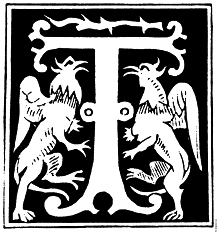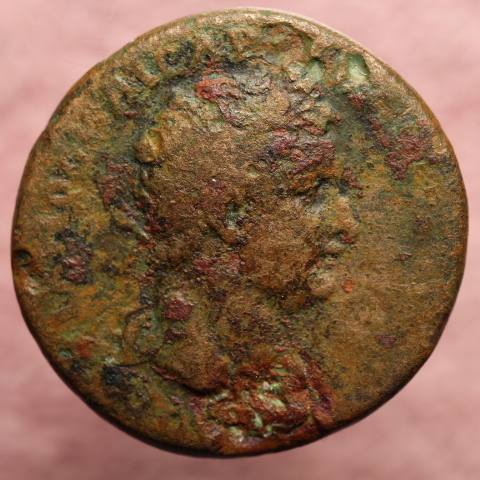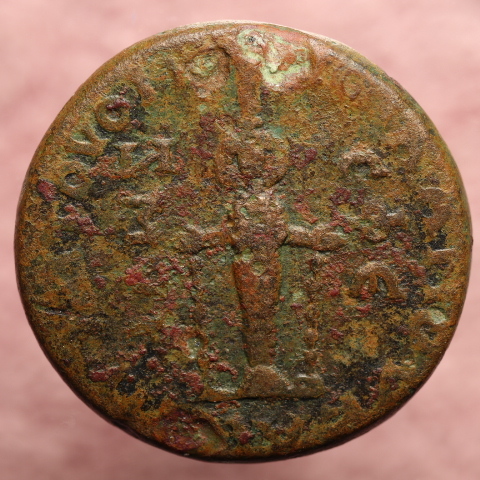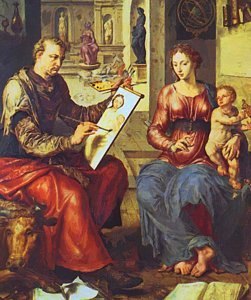Μεγαλύνει ἡ ψυχή μου τὸν κύριον, καὶ ἡγαλλίασεν τὸ πνεῦμά μου ἐπι τῷ θεῷ τῷ σωτῆρί μου,
ὅτι ἐπέβλεψεν ἐπὶ τὴν ταπείνωσιν τῆς δούλης αὐτοῦ. ἰδοὺ γὰρ ἀπὸ τοῦ νῦν μακαριοῦσίν με πᾶσαι αἱ γενεαί.
Magnificat anima mea Dominum. et exultavit spiritus meus: in Deo salutari meo.
quia respexit humilitetem ancillae suae: ecce enim ex hoc beatam me dicent omnes generationes.
My soul doth magnify the Lord, and my spirit hath rejoiced in God my Saviour.
For he hath regarded the low estate of his handmaiden: for, behold, from henceforth all generations shall call me blessed.
"The Magnificat," Luke 1:47-48 (KJV, here and throughout this article)
 HERE HAD BEEN TROUBLE between Smyrna and Ephesus. We don't know what the problem was, whether it had to do with religion or with trade or with the right of asylum in the Temple of Artemis, but no matter what the conflict was about, it was serious. Before the pax Romana it might have meant war. The good news is the two cities somehow patched things up. Ephesus and Smyrna were reconciled, the conflict was resolved. This coin from Ephesus, RPC 1089, is evidence of that--
HERE HAD BEEN TROUBLE between Smyrna and Ephesus. We don't know what the problem was, whether it had to do with religion or with trade or with the right of asylum in the Temple of Artemis, but no matter what the conflict was about, it was serious. Before the pax Romana it might have meant war. The good news is the two cities somehow patched things up. Ephesus and Smyrna were reconciled, the conflict was resolved. This coin from Ephesus, RPC 1089, is evidence of that--


Much of the inscription is worn away, though we know what it says from other examples. (This is a rare coin, no question, but there are at least six other known specimens.) The important elements to this discussion are evident to the naked eye. On the reverse from about nine o'clock to eleven o'clock is most of the Greek word ὁμόνοια, OMONOIA, unity, concord. There is debate about what this means on coins; it could simply indicate an informal and unofficial alliance of some sort (Rome did not permit its provincial cities their own formal or official alliances) or it could mark the ending of a serious dispute, which is the way I am taking it. In the field to the left you can see some of ΣMYP (the Σ here looks like a Z reversed) for Smyrna; and in the field to the right, ΕΦΕ for Ephesus. The figure in the center depicts the cult statue of Artemis from the Ephesian Temple of Artemis. This statue is so old it's older than recorded memory. The temple complex itself was one of the original Seven Wonders of the World, which list included the Great Pyramid at Giza, the Colossus of Rhodes, and the Hanging Gardens of Babylon!
There was another Wonder in Ephesus at the time of Domitian, though not many people knew it, a Wonder of the Universe in fact. Mary lived here, under the care of the Beloved Disciple. Mary, the Immaculate Conception, the very Mother of God!
* * *
My church is offering a book study this summer. We're going to be reading The First Christmas: What the Gospels Really Teach About Jesus's Birth (Borg & Crossan, New York, 1989). We are celebrating Christmas in July because somebody wisely decided that the Advent season is already too busy. True enough.
So I start reading ahead. In Chapter One the book highlights a number of conflicts between the two nativity stories of Matthew and Luke. According to the book, there are more problems here than most Christians realize: For one thing, Matthew seems to be telling one story and Luke tells another. In addition to that there are two major contradictions, one about geography and one about genealogy. All of this is true, and to be fair to the book the authors aren't too worried about these conflicts, hesitating even to call the contradictions "contradictions."
(At this point I am going to pause while you take out your Bibles. I don't want to have to quote a lot of scripture in this article. We're only talking about the first two chapters of Matthew and the first two chapters of Luke, and also Luke 3:23-38. Mark doesn't write about Christmas and neither does John. So take another look at the material--it's pretty short and the story is familiar--and while you're doing that I am going out to the kitchen to make myself a sandwich. . . .)
I'm back, and you're prepared. Excellent. Do you see the different incidents each author has chosen to write about? Did you note the two rather striking contradictions? If these seeming conflicts are new to you you might be asking, are Matthew and Luke writing about the same person? The two contradictions are even more worrisome. If a person never noticed before that Matthew's Christmas story has the Holy Family living in Bethlehem and then moving to Nazareth after escaping to Egypt for a while and Luke's story has them visiting Bethlehem and then returning home to Nazareth or that the genealogies totally contradict each other, he might start to wonder if one story is fact and the other fiction or if they're both just made up out of whole cloth.
The study book addresses this problem in Chapter Two. In fact it offers a third alternative to the question whether the stories are fact or fable, offering us an easy out, what the authors call "parabolic truth," truthful but not historically factual. Didn't George W. Bush once call that "truthiness"? Maybe it was somebody else, but I call it a greasy sideways approach to any Bible question.
That's my opinion anyway. I happen to believe in the literal truth of the New Testament, and I don't need to resort to the dodge (as the authors insist us literalists must do) that with God all things are possible. Saying that something isn't factually true but parabolically true is lazy. First of all, regarding the different incidents, I say that each evangelist has the perfect right to include, among all of the possible incidents, those particular incidents that best make his particular point. Matthew told one half of the story and Luke told the other half. I don't have a problem with that. If each of the four evangelists had told exactly the same story, why would the compiler Irenaeus have bothered to include all four gospels in the canon?
Anyway that's enough about that. I'm not going to spend any more time on the incidents. What I mainly want to deal with in this blog article are the two contradictions. First I need to posit what might seem to be an obvious point. Apparently there was sufficient first-century interest in Christ's birth and early life so that both Matthew and Luke (independently) felt the need to put the true story on the record. There happened to be a living eye-witness to the Nativity residing in Ephesus. Wouldn't both writers have tried to move heaven and earth in order to interview her? It seems so obvious, in fact the alternative seems so unlikely, but to my knowledge nobody's ever brought up this point before: Matthew and Luke needed to talk to Mary!
A written document doesn't change from day to day. It says what it says and that's it. A living source, on the other hand, can be subject to forgetfulness and deceit; even a reliable witness with a perfect memory and honest factual testimony can deliver different answers to the same question if the question is asked in different ways: slightly different questions, different answers, prompting different follow-up questions, resulting in totally different interviews, resulting in different stories. Consider the following two questions--
Matthew: "If Jesus was born in Bethlehem, how come he grew up in Nazareth?"
Luke: "If Jesus grew up in Nazareth, how come he was born in Bethlehem?"
The two questions are practically identical. In fact they are mirror images of each other. Of course they elicit totally different answers even from the same set of facts.
Matthew needed to establish Jesus's birth in Bethlehem in order that the scripture in Isaiah might be fulfilled, "And thou Bethlehem, in the land of Juda, art not the least among the princes of Juda: for out of thee shall come a Governor, that shall rule my people Israel," but he had to place his eventual home in Nazareth to fulfill another prophecy, "He shall be called a Nazarene," so he asked the question in one way. Mary's answer to him gives the details about the circuitous route from Bethlehem to Nazareth but doesn't include the stable and manger, the choir of angels, or the shepherds.
Luke, a cosmopolitan world-traveler in an age when must people lived and died in the same town where they were born, perhaps had a more personal reason for the way he asked his question. Mary's answer explains what brought the family to Bethlehem in the first place but leaves out the star and wisemen, the flight to Egypt, and the slaughter of the innocents.
My impression is that Matthew only got the single interview. The event would have required a sea voyage from Antioch, a strenuous undertaking for someone of Matthew's accumulated years. Moreover the Johanine church was suffering intense persecution by the synagogue Jews. Despite his pedigree they would have considered Matthew a Jew, a keeper of the Law. This evangelist would not have felt welcome in Ephesus. His reception would have been tepid if not hostile. I'm guessing Matthew got his interview and then right away booked passage on the next boat east.
Luke felt more comfortable in Ephesus. He seems particularly at home with the strong contingent of John the Baptist's former disciples in that church. By the time of Paul's missionary work recorded in Acts Luke was living in Troas in Asia Minor, a couple hundred miles from Ephesus. He died not too much farther away than that in Boeotia in central Greece in 84, three year's into Domitian's reign as emperor. Perhaps he visited often. Perhaps his wasn't so much an interview with Mary as a series of conversations. Traditionally he painted her portrait from life and according to his own gospel he seems to have been privy to information that Mary didn't tell anybody else but "kept in her heart." Here is a painting by Maerten van Heemskerk--

This question is beside the point and a little bit meta, but who is the baby? Of course both young models are actually residents of sixteenth-century Heemskirk, but who is that child in the Madonna's lap that St Luke is supposed to be painting? Some little one of John's church, I'm guessing, or maybe Mary's grandson? With God all things are possible :)
Anyway, getting back to business here, the second major conflict is harder to deal with. The two genealogies do actually contradict each other. Clearly one has to be wrong. A mistake would be easier to understand and forgive, if forgiveness is necessary, than an outright falsehood, because a deliberate falsehood would throw the whole gospel into question. A mistake (either as an original misapprehension, a mishearing, an error in writing it down, an error in reading an indecipherable scribble, or an error in later redaction) seems so much more likely than a falsehood (since, as much as Matthew wanted the unbroken linkage back to David, the genealogy section could have been omitted entirely without anybody missing it). I vote we go ahead and dismiss the latter as a possibility. It was a mistake, not a falsehood.
Here's what I think may have happened. As a dutiful daughter, Mary would have known her father's lineage; as a dutiful wife, she would have learnt Joseph's by heart. Mary was a member of John's church, a church with a high christology (indeed fostered by Mary), where Joseph was not considered to be the father of Jesus. So the bloodline through Joseph was irrelevant. Perhaps Luke specifically asked about the genealogy of Jesus's house, which of course would have meant Joseph's, and perhaps Matthew asked a generic question about the genealogy of Jesus, which according to anyone in John's church would have meant Mary's alone, or more properly for her culture, her father's. Therefore Luke got Joseph's genealogy and Matthew got Mary's father's. In the apocryphal Gospel of James (Ronald F. Hock, The Infancy Gospels of James and Thomas, 1995, Santa Rosa) Mary's father's name is given as Joachim (Ἰωακείμ). Perhaps this name was unfamiliar to a future editor who unwittingly changed it to Jacob (Ἰακὼβ), a much more familiar name, and so that's how it appears in Matthew's genealogy. This is just one possible explanation.
Soon: SALVTI AVGVSTI: Concerning Domitian's poor health on his return from Germany.

